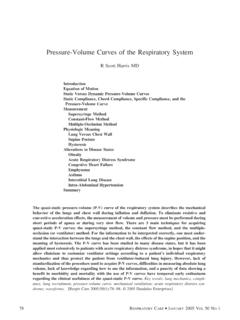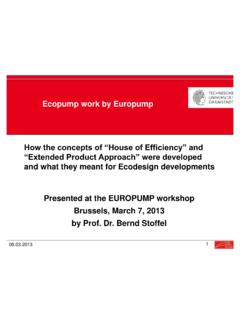Transcription of Stephanie The ventilation system for neonatology
1 StephanieThe ventilation system for neonatology + Conventional ventilator + High-frequency oscillator+ Proportional Assist ventilation (PAV )+ Integrated patient gas humidifier+ Minimum volume guarantee+ Innovative Closed Loop ventilation + Dead space free ventilation control with external respiration sensor+ Synchronized, non-invasive ventilationPediatricsThe highlights Conventional respiraitonSTEPHANIE provides all conventional ventila-tion modes such as CPAP, S-IMV, A/C (assisted/controlled ventilation ), V-CMV (volume-controlled ventilation ) with various inspiration flow patterns as well as P-CMV (pressure-controlled ventilation ) with various inspiratory pressure pattern.
2 The V-CMV mode is equipped with leak-gas compensation with which the inspiratory leakage frequently associated with premature infants can, to a great extent, be offset. Stephanie now also offers PSV for patient-triggered ventilation ventilationPremature infants undergoing controlled ventilation tend to synchronize their respiration to the ventilator s rhythm, resulting in so-called entrainment . This can result in an undesirably high inspiration tidal volume and a possible volume trauma. In order to counteract this tendency, the P-CMV of the new Stephanie provides volume limitation. Once the expirationvolume reaches the volume limit, the pressure of the sub-sequent inspiration is limited or applied at the lowest possible ventilation pressure, thus safely and quickly preventing an excessively high tidal volume.
3 We refer to this as the minimum volume guarantee . Stephanie The ventilation system for neonatology Success in the area of top-class medical technology lies in the details. And it is in thesedetails that the Stephanie neonatal ventilation system excels. From the outset, Fritz Stephan GmbH has specialized in solutions associated with ventilation in the area of neonatology and pediatrics. Through its many years of working closely with hospitals, Fritz Stephan GmbH is well aware of the demands medical personnel place on their tools . The unique combination of ventilator, patient gas humidifier, oscillator and monitor available for the first time in this unit opens previously unimagined possibilities with regards to diagnostics and is an excellent example of how clinical experience and technical expertise can lead to an outstanding integrated high-frequency oscillation ventilation (HFOV ) can be initiated at the push of a button and without any delay or the necessity of changing patient tubes.
4 The unique patient ventilator means that there are no additional compressible volumes which can reduce the performance of the gas conditioningThe integrated, heated patient gas humidification system generates saturated and warmed respiration gas ahead of the inspiration valve, in other words, within the ventilator so to speak. The heated patient tubes provide temperature monitoring when carrying the gas to the patient. Intelligent sensors compensate any temperature differences. This helps avoid both frequent patient tube changes as well as preventingPediatricsthe ormation of condensation in the tubes, thusincreasing the hygienic monitoring by means of the integrated " TFT monitor visualizes all relevant respiratory para-meters.
5 The patient s overall vital signs can be quickly and comprehensively additional special feature offered bySTEPHANIE lies in the expansion of the conventio-nal ventilation modes to include Proportional Assist ventilation (PAV ), which reduces obstructive or resistive stresses on natal lungs in a volume- or flow-proportional manner, thus aiding in compensating for these The ventilation system for neonatology High-frequency oscillationThe integrated high-frequency oscillation represents one of the characteristics which sets this system apart. It can be activated at the push of a button, and frequency, amplitude as well as the I/E ratio are all ad-justable. The wide adjustment range of the Mean Airway Pressure (MAP) up to 30 cmH2O provides reliable oxygenation.
6 The precision monitoring fully developed for Stephanie permits even thesmallest volumes to be measured during HFOV, even at very high frequencies. Thanks to the effective amplitude (stroke volume: approx. 24 ml), patients weighing up to 10 kg can be reliably oscillated. Proportional Assist ventilation (PAV ) The integrated elastic and resistive relief procedure allows medical personnel to employ the so-called Proportional Assist ventilation (PAV ) method. This respiration treatment achieves a reduction in the resistive and elastic respiration stresses while fully maintaining the spontaneous breathing pattern. The goal of Proportional Assist ventilation lies in the determination and selective support of the patient s breathing effort.
7 In doing this, the pressure during inspiration increases proportionally with the tidal volume breathed in and/or the respiration gas flow. Thus, neither ventilation times nor inspiration pressures or tidal volumes are predefi ned. Instead, Stephanie adapts itself to the patient s own bio-logical breathing regulation. In their effect, the pres-sure increases overlay the respiratory path resistance and the lung compliance, thus producing a reduction in the overall effort required for breathing. What this means is that, at a given level of lung effort, greater breath-minute volumes can be breathed: Proportional Assist ventilation thus reduces the stress on spontaneously breathing is a safe respiration treatment since the spon-taneous breathing efforts are continuously moni-tored and a backup ventilation utilizing conventional S-IMV automatically takes over if the tidal volumes being breathed become too low or if spontaneous respiration backup ventilation permits a more subtle form of respiration support for children with breathing insuf-ficiencies.
8 Apneas or a large reduction of spontaneous breathing in premature infants are characterized by drops in oxygen saturation due to insufficient pulmo-nary aeration. If an apnea is followed by a resumption of spontaneous breathing, there is a time delay before the oxygen saturation of the blood increases. Because of this time delay, switching the backup ventilation off immediately upon the resumption of spontaneousPediatricsbreathing can result in a renewed reduction in the oxygen saturation level. A slow disengagement of the backup ventilation therefore appears advisable. The new backup venti-lation control provided by Stephanie does not allow the patient to completely switch the backup ventilation off once spontaneous breathing resumes, but instead, only permits a reduction in the mechanical respiration The ventilation system for neonatology Non invasive ventilation (NIV )The benefits of a non-invasive ventilation therapy for newborn or prematurely born babies have beenestablished by several scientific studies ( COIN study).
9 The application of NIV permits lung-pro-tective ventilation strategies thus helping reduce the occurrence of air leak syndromes and BPD. The use of NIPPV reduces the danger of ventilation failure after extubation and therefore significantly reduces the incidence of reintubation. A newly developed system of Fritz Stephan GmbH detects the abdo-minal movement of patients by means of an external respiration sensor. This is then converted into a stable, fast-reacting (<30ms) trigger signal, thus allowing SNIPPV which can further improve the efficiency of ventilation . Although the BPD rate has the ten-dency to be lowered by an early application of NIV, the risk of pneumothorax may increase (especially in very prematurely born babies) since exogenous surfactants can only be safely applied to an intubated patient.
10 Due to its innovative control system , Stephanie allows swift changes between invasive and non-invasive ventilation thus allowing the optimal support of the so-called INSURE method(INtubation-SURfactant-Extubation) . Closed Loop ventilation Stephanie is equipped with an additional, safety-related innovation with regard to backup ventilation : the so-called Closed Loop ventilation . The SpO2 data acquired by the NEOSID NOVA Pulsoximeter (Fritz Stephan GmbH) provide information regarding the oxygen saturation status. The frequency, duration and severity of decreases in the oxygen saturation level can be directly determined and can be independently corrected by the selective employment of thebackup ventilation .


